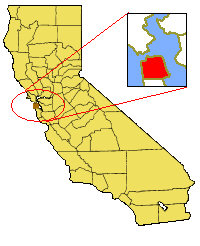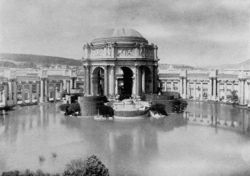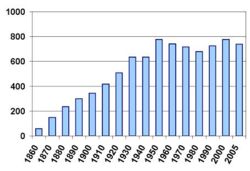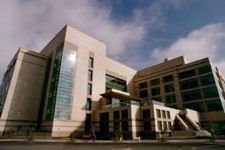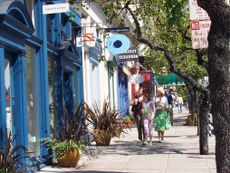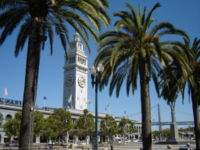San Francisco, California
2007 Schools Wikipedia Selection. Related subjects: North American Geography
| City and County of San Francisco | |||||
|
|||||
| Nickname: "The City by the Bay; Fog City" | |||||
| Location of the City and County of San Francisco, California | |||||
| Coordinates: | |||||
|---|---|---|---|---|---|
| Country | United States of America | ||||
| State | California | ||||
| City-County | San Francisco | ||||
| Mayor | Gavin Newsom | ||||
| Area | |||||
| - City | 122 km² (47 sq mi) | ||||
| - Land | 121.0 km² (46.7 sq mi) | ||||
| - Water | 479.7 km² (185.2 sq mi) | ||||
| - Metro | 8,869.3 km² (3,424.4 sq mi) | ||||
| Elevation | 16 m (52 ft) | ||||
| Population | |||||
| - City (2006) | 798,680 (est) | ||||
| - Density | 6,115/km² (15,837/sq mi) | ||||
| - Urban | 3,385,000 | ||||
| - Metro | 4,152,688 | ||||
| Time zone | Pacific Standard Time ( UTC-8) | ||||
| - Summer ( DST) | Pacific Daylight Time ( UTC-7) | ||||
| Website: http://www.sfgov.org | |||||
The City and County of San Francisco is the fourth most populous city in California and the fourteenth-most populous in the United States, with a 2006 population of 798,680 (estimate). It is located on the tip of the San Francisco Peninsula and is the focal point of the San Francisco Bay Area. San Francisco is the second most densely populated major city in the United States.
In 1776, the Spanish settled the tip of the San Francisco peninsula, establishing a fort at the Golden Gate and a mission named for Francis of Assisi. As a result of the California Gold Rush in 1848, the city entered a period of rapid growth. After being devastated by the 1906 earthquake and fire, San Francisco was quickly rebuilt.
San Francisco is renowned for its months-long episodes of fog, steep rolling hills, an eclectic mix of Victorian and modern architecture, its peninsular location (surrounded by the Pacific Ocean and San Francisco Bay), and its liberal cultural and political identity. Famous hallmarks and landmarks include the Golden Gate Bridge, Alcatraz Island, the cable cars, the Transamerica Pyramid, Coit Tower, and Chinatown.
History
The earliest archaeological evidence of inhabitation of the territory of the city of San Francisco dates to 3000 BC. The Yelamu group of the Ohlone people resided in several small villages when a Spanish exploration party, led by Don Gaspar de Portolà arrived on November 2, 1769, the first documented European discovery of San Francisco Bay. Seven years later, on March 28, 1776 the Spanish established a fort, followed by a mission, Mission San Francisco de Asís (Mission Dolores).
Upon independence from Spain in 1821, the area became part of Mexico. In 1835, Englishman William Richardson erected the first significant homestead outside the immediate vicinity of the Mission Dolores, near a boat anchorage around what is today Portsmouth Square. Together with Mission Alcalde Francisco de Haro, he laid out a street plan for the expanded settlement, and the town, named Yerba Buena, began to attract American settlers. Commodore John D. Sloat claimed California for the United States on July 7, 1846, during the Mexican-American War, and Captain John B. Montgomery arrived to claim Yerba Buena two days later. Yerba Buena was renamed San Francisco the next year. Despite its attractive location as a port and naval base, San Francisco was still a small settlement with inhospitable geography.
The California Gold Rush brought a flood of treasure seekers. With their sourdough bread in tow, prospectors accumulated in San Francisco over rival Benicia, raising the population from 1,000 in 1848 to 25,000 by December 1849. The promise of riches was so strong that crews on arriving vessels deserted and rushed off to the gold fields, leaving behind a forest of masts in San Francisco harbour. California was quickly granted statehood and the U.S. military built Fort Point at the Golden Gate and a fort on Alcatraz island to secure the San Francisco Bay. Silver discoveries, including the Comstock Lode in 1859, further drove rapid population growth. With hordes of fortune seekers streaming through the city, lawlessness was common, and the Barbary Coast section of town gained notoriety as a haven for criminals, prostitution, and gambling.
Entrepreneurs sought to capitalize on the wealth generated by the Gold Rush. Early winners were the banking industry, which saw the founding of Wells Fargo in 1852, and the railroad industry, as the magnates of the Big Four, led by Leland Stanford, collaborated in the building of the First Transcontinental Railroad. The development of the Port of San Francisco established the city as a centre of trade. Catering to the needs and tastes of the growing population, Levi Strauss opened a dry goods business and Domingo Ghirardelli began manufacturing chocolate. Immigrant laborers made the city a polyglot culture, with Chinese railroad workers creating the city's Chinatown quarter. The first cable cars carried San Franciscans up Clay Street in 1873. The city's sea of Victorian houses began to take shape, and civic leaders campaigned for a spacious public park, resulting in plans for Golden Gate Park. San Franciscans built schools, churches, theaters, and all the hallmarks of civic life. The Presidio developed into the most important American military installation on the Pacific coast. By the turn of the century, San Francisco was a city of international renown, celebrated for a flamboyant style, stately hotels, ostentatious mansions on Nob Hill, and a thriving arts scene.
At 5:12 AM on the morning of April 18, 1906, a major earthquake struck San Francisco and northern California. As buildings collapsed from the shaking, ruptured gas lines ignited fires that would spread across the city and burn out of control for several days. With water mains out of service, the Presidio Artillery Corps attempted to contain the inferno by dynamiting blocks of buildings to create firebreaks. More than three-quarters of the city lay in ruins, including almost all of the downtown core. Contemporary accounts reported that 498 people lost their lives, though modern estimates put the number in the several thousands. More than half the city's population of 400,000 were left homeless. Refugees settled temporarily in makeshift tent villages in Golden Gate Park, the Presidio, on the beaches, and elsewhere. Many fled permanently to the East Bay.
Rebuilding was rapid and performed on a grand scale. Rejecting calls to completely remake the street grid, San Franciscans opted for speed. Amadeo Giannini's Bank of Italy, later to become Bank of America, provided loans for many of those whose livelihoods had been devastated. The destroyed mansions of Nob Hill became grand hotels. City Hall rose once again in Beaux Arts splendor, and the city celebrated its rebirth at the Panama-Pacific International Exposition in 1915.
In ensuing years, the city solidified its standing as a financial capital; in the wake of the 1929 stock market crash, not a single San Francisco-based bank failed. Indeed, it was at the height of the Great Depression that San Francisco undertook two great civil engineering projects, simultaneously constructing the San Francisco-Oakland Bay Bridge and the Golden Gate Bridge, completing them in 1936 and 1937 respectively. It was in this period that the island of Alcatraz, a former military stockade, began its service as a federal maximum security prison, housing notorious inmates such as Al Capone. San Francisco later celebrated its regained grandeur with a World's Fair, the Golden Gate International Exposition in 1939-40, creating Treasure Island in the middle of the bay to house it.
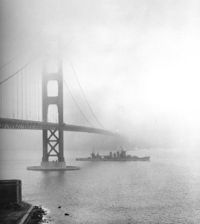
During World War II, the Hunters Point Naval Shipyard became a hub of activity and Fort Mason became the primary port of embarkation for service members shipping out to the Pacific theatre of operations. The explosion of jobs drew many people, especially African Americans from the South, to the area. After the end of the war, many military personnel returning from service abroad and civilians who had originally come to work decided to stay. The UN Charter creating the United Nations was drafted and signed in San Francisco in 1945 and, in 1951, the Treaty of San Francisco officially ended the war with Japan.
Urban planning projects in the 1950s and 1960s saw widespread destruction and redevelopment of westside neighborhoods and the construction of new freeways. The Transamerica Pyramid was completed in 1972, and in the 1980s the Manhattanization of San Francisco saw extensive high rise development downtown. Port activity moved to Oakland, the city began to lose industrial jobs, and San Francisco began to turn to tourism as the most important segment of its economy. The suburbs experienced rapid growth and San Francisco underwent significant demographic change, as large segments of the white population left the city, supplanted by an increasing wave of immigration from Asia and Latin America.
Over this same period, San Francisco became a magnet for America's counterculture. Beat Generation writers fueled the San Francisco Renaissance and centered on the North Beach neighbourhood in the 1950s. Hippies flocked to Haight-Ashbury in the 1960s, reaching a peak with the 1967 Summer of Love. In the 1970s, the city became a centre of the gay rights movement, with the emergence of The Castro as an urban gay village, the election of Harvey Milk to the Board of Supervisors, and his assassination, along with that of Mayor George Moscone, in 1978.
The 1989 Loma Prieta earthquake caused destruction and loss of life throughout the Bay Area. In San Francisco, the quake severely damaged structures in the Marina and South of Market districts and precipitated the demolition of the damaged Embarcadero Freeway and much of the damaged Central Freeway, allowing the city to reclaim its historic downtown waterfront.
During the dot-com boom of the late 1990s, startup companies invigorated the economy. Large numbers of entrepreneurs and computer application developers moved into the city, followed by marketing and sales professionals that changed the social landscape as once poorer neighborhoods became gentrified. When the bubble burst in 2001, many of these companies folded and their employees left, although high technology and entrepreneurship continued to be mainstays of the San Francisco economy.
Geography
San Francisco is located on the west coast of the U.S. at the tip of the San Francisco Peninsula and includes significant stretches of the Pacific Ocean and San Francisco Bay within its boundaries. Several islands are part of the city, notably Alcatraz, Treasure Island, and the adjacent Yerba Buena Island. Also included are the uninhabited Farallon Islands, 27 miles (43 km) offshore in the Pacific Ocean. The land within the city limits roughly forms a seven by seven mile square, which has become a colloquialism referring to the city's shape.
San Francisco is famous for its hills, which are defined as elevations over 100 feet (30 m). There are a total of 43 hills within city limits. Some neighborhoods are named after the hill on which they are situated, including Nob Hill, Pacific Heights, Russian Hill, Potrero Hill, and Telegraph Hill.
Near the geographic centre of the city, southwest of the downtown area, are a series of less densely populated hills. Dominating this area is Mount Sutro, the site of Sutro Tower, a large red and white radio and television transmission tower. Nearby is Twin Peaks, a pair of hills resting at one of the city's highest points and a popular overlook spot for tour groups. San Francisco's tallest hill, Mount Davidson, is 925 feet (282 m) high, and is capped with a 103 feet (31.4 m) tall cross built in 1934.
The San Andreas and Hayward Faults are responsible for much earthquake activity, even though neither passes through the city itself. It was the San Andreas Fault which slipped and caused the earthquakes in 1906 and 1989. Minor earthquakes occur on a regular basis. The threat of major earthquakes plays a large role in the city's infrastructure development. New buildings must meet high structural standards, and older buildings and bridges must be retrofitted to comply with new building codes.
San Francisco's shoreline has grown beyond its natural limits. Entire neighborhoods such as the Marina and Hunters Point, as well as large sections of the Embarcadero sit on areas of landfill. Treasure Island was constructed from material dredged from the bay as well as material resulting from tunneling through Yerba Buena Island during the construction of the Bay Bridge. Such land tends to be unstable during earthquakes; the resultant liquefaction causes extensive damage to property built upon it, as was evidenced in the Marina district during the 1989 Loma Prieta Earthquake.
Climate
A quotation incorrectly attributed to Mark Twain goes, "The coldest winter I ever spent was a summer in San Francisco." San Francisco benefits from California’s Mediterranean climate, characterized by mild wet winters and warm dry summers. However, surrounded on three sides by water, San Francisco has a climate strongly influenced by the cool currents of the Pacific Ocean which tends to moderate temperature swings and produce a remarkably mild climate with little seasonal temperature variation. Average summertime high temperatures in San Francisco peak at 70 °F (21 °C) and are 20 °F (9 °C) lower than they are in nearby inland locations like Livermore. The highest temperature ever recorded in San Francisco was 103 °F (39 °C) on June 14, 2000. Winters are mild, with daytime highs near 60 °F (15 °C). Lows almost never reach freezing temperatures, though the lowest temperature ever recorded in San Francisco was 27 °F (-3 °C) on December 11, 1932. May through September are quite dry, and rain is a common occurrence from November through March. Snow is extraordinarily rare, with only 10 instances recorded since 1852. The last measurable snowfall in San Francisco was on February 5, 1976, when parts of the city experienced as much as five inches.
The combination of cold ocean water and the high heat of the California mainland creates the city's characteristic fog that can cover the western half of the city all day during the summer and early fall. The fog is less pronounced in eastern neighborhoods, in late spring, and during September and October, which are the warmest months of the year. Due to its sharp topography and maritime influences, San Francisco exhibits a multitude of distinct microclimates. The high hills in the geographic centre of the city are responsible for a 20% variance in annual rainfall between different parts of the city. They also protect neighborhoods directly to their east from the foggy and cool conditions experienced in the Sunset District; for those who live on the eastern side of the city, San Francisco is fairly sunny, with an average of 160 clear days, and only 105 cloudy days per year.
| Weather averages for San Francisco, California | |||||||||||||
| Month | Jan | Feb | Mar | Apr | May | Jun | Jul | Aug | Sep | Oct | Nov | Dec | Year |
|---|---|---|---|---|---|---|---|---|---|---|---|---|---|
| Avg high °F (°C) | 56 (13) | 60 (15) | 61 (16) | 63 (17) | 64 (17) | 66 (18) | 66 (18) | 66 (18) | 70 (21) | 69 (20) | 64 (17) | 57 (13) | 63 (17) |
| Avg low °F (°C) | 46 (7) | 48 (8) | 49 (9) | 50 (10) | 51 (10) | 53 (11) | 54 (12) | 54 (12) | 56 (13) | 55 (12) | 51 (10) | 47 (8) | 51 (10) |
| Precipitation, in (cm) | 4.1 (10) | 3.5 (8) | 2.9 (7) | 1.5 (3) | 0.5 (1) | 0.2 (0.5) | --- | --- | 0.2 (0.5) | 1.1 (2) | 2.6 (6) | 3.9 (9) | 20.4 (51) |
| Source: Weatherbase Nov 2006 | |||||||||||||
Neighborhoods
The historic centre of San Francisco is the northeast quadrant of the city bordered by Market Street to the south. It is here that the Financial District is centered, with Union Square, the principal shopping and hotel district, nearby. Cable cars carry residents and tourists alike up steep inclines to the summit of Nob Hill, once the home of the city's business tycoons, and down to Fisherman's Wharf, a tourist playground featuring Dungeness crab from a still-active fishing industry. Also in this quadrant are Russian Hill, a residential neighbourhood with the famously crooked Lombard Street, North Beach, the city's version of Little Italy, and Telegraph Hill, which features Coit Tower, a landmark dedicated to San Francisco's firefighters. Nearby is San Francisco's Chinatown, established in the 1860s. The Tenderloin is often portrayed as the crime-infested underbelly of the city.
The Mission District is predominantly working-class and populated by immigrants from Mexico and Central America, but is also gentrifying. Haight-Ashbury, though heavily gentrified, still has some bohemian character. The Castro is the centre of gay life in the city, having recovered from the devastation it suffered during the AIDS epidemic.
The city's Japantown district suffered when its residents were forcibly removed during the second world war, while the nearby Western Addition became established with a large African American population at the same time. The " Painted Ladies", a row of well-restored Victorian homes, stand alongside Alamo Square, and the mansions built by the San Francisco business elite in the wake of the 1906 earthquake can be found in Pacific Heights. The Marina to the north is a lively area with many young urban professionals.
The Richmond, the vast region north of Golden Gate Park that extends to the Pacific Ocean, today has a portion called "New Chinatown", but also attracts immigrants from other parts of Asia and Russia. South of Golden Gate Park lies the Sunset with an Asian majority population. The Richmond and the Sunset are largely middle class and, together, are known as The Avenues. The southern neighborhoods of the city are ethnically diverse and populated primarily with students and working class San Franciscans.
The South of Market, once filled with decaying remnants of San Francisco's industrial past, has seen significant redevelopment. The locus of the dot-com boom during the late 1990s, by 2004 South of Market began to see skyscrapers and condominiums dot the area. Following the success of nearby South Beach, another neighbourhood, Mission Bay, underwent redevelopment, anchored by a second campus of UCSF.
Beaches and parks
Ocean Beach runs along the Pacific Ocean shoreline, and Baker Beach occupies a picturesque setting just west of the Golden Gate Bridge. They are not suitable for swimming because the waters off the coast are cold and have deadly rip currents. The biggest and most well-known park is Golden Gate Park, stretching from the centre of the city to the ocean. Once covered only in grass and sand dunes, the park is planted with thousands of non-native trees and plants and is rich with attractions including the Conservatory of Flowers, the Japanese Tea Garden, and Strybing Arboretum. The Presidio, a former military base, and its Crissy Field section, restored to its natural salt marsh condition, are part of the Golden Gate National Recreation Area, which includes Alcatraz, and other regional parks. Buena Vista Park is the city's oldest, established in 1867. Lake Merced is a fresh-water lake surrounded by parkland.
Demographics
The estimated 2006 population of San Francisco is 798,680, surpassing the dot-com boom peak of 776,733 in 2000. With nearly 16,000 people per square mile, San Francisco is the second most densely populated major American city after New York. San Francisco is the traditional focal point of the San Francisco Bay Area and forms part of the greater San Jose-San Francisco- Oakland Combined Statistical Area (CSA) whose population is over 7 million - the fifth largest in the United States as of the 2000 census.
San Francisco is a minority-majority city as non-Hispanic Whites make up less than 44% of the population. Asian Americans, principally Chinese, comprise nearly 31% of the population. Hispanics of any race make up just over 14% of the population. At less than 8% of the population, San Francisco has a lower concentration of African Americans than the United States as a whole. Few of San Francisco's residents have lived there their whole lives. Only 35% of its residents were born in California; 39% were born outside the United States.
San Francisco has the highest percentage of same-sex households of any American county, with the Bay Area having a higher concentration than any other metropolitan area. Gay men outnumber lesbians; it has been estimated that one in five males over the age of 15 is gay.
The San Francisco median household income, at $57,496 in 2005, is the fifth-highest for any large city in the nation. Following a national trend, an out-migration of middle class families is contributing to widening income disparity and has left the city with a lower proportion of children, 14.5%, than any other large city in the United States. Nevertheless, the poverty rate, at 7.8%, is lower than the national average and among the lowest for cities ranked by the U.S. Census Department.
Homelessness has been a chronic and controversial problem for San Francisco since the early 1980s. The city is believed to have the highest number of homeless inhabitants per capita of any major city in the United States. The rates of violent and property crime, reported for 2003 as 742 and 4943 incidents per 100,000 residents respectively, are higher than the national average. Among the 50 largest U.S. cities by population, San Francisco ranks 32nd and 38th in each of those categories.
Government
The City and County of San Francisco is a consolidated city-county, a status it has had since 1856. It is the only such consolidation in California. The mayor is also the county executive and the county board of supervisors acts as the city council. Because of its unique status, it exercises jurisdiction over property that would otherwise be located outside of its corporation limit. San Francisco International Airport, though located in San Mateo County, is owned and operated by the City and County of San Francisco. San Francisco was also granted a perpetual leasehold over the Hetch Hetchy Valley and watershed in Yosemite National Park by the Raker Act in 1913.
Under the city charter, the Government of San Francisco is constituted of two co-equal branches. The executive branch is headed by the mayor and includes other city-wide elected and appointed officials, and the civil service. The 11-member Board of Supervisors, the legislative branch, is headed by a President ( Aaron Peskin, as of 2006) and is responsible for passing laws and budgets, though San Franciscans also make use of direct ballot initiatives to pass legislation. The members of the Board of Supervisors are elected as representatives of specific districts within the city. If the mayor dies or resigns, the President of the Board of Supervisors assumes the office, as Dianne Feinstein did after the assassination of George Moscone in 1978. The municipal budget in 2006 was greater than $5 billion.
The federal government utilizes San Francisco as the regional hub for many arms of the federal bureaucracy, including the U.S. Court of Appeals, the Federal Reserve Bank, and the United States Mint. Until decommissioning in the early 1990s, the city had three major military installations - the Presidio, Treasure Island, and Hunters Point - a legacy still reflected in the annual celebration of Fleet Week. The State of California uses San Francisco as the home of the state Supreme Court and other state agencies. Foreign governments have located in excess of thirty foreign consulates in San Francisco.
Economy
Tourism is the backbone of the San Francisco economy. Its frequent portrayal in music, film, and popular culture has made the city and its landmarks recognizable worldwide. It is the city where Tony Bennett left his heart, where the Birdman of Alcatraz spent many of his final years, and where Rice-a-Roni was said to be the favorite treat. San Francisco attracts the fifth highest number of foreign tourists of any city in the United States and claims Pier 39 near Fisherman's Wharf to be the third-most popular tourist attraction in the nation. More than 15 million visitors came to San Francisco in 2005, injecting nearly $7.5 billion into the economy. With a large hotel and restaurant infrastructure and a world-class facility in the Moscone Centre, San Francisco also is a top-ten North American destination for conventions and conferences.
The legacy of the California Gold Rush turned San Francisco into the principal banking and finance centre of the west coast. Montgomery Street in the Financial District is known as the "Wall Street of the West", home to the Federal Reserve Bank of San Francisco and formerly the site of the Pacific Exchange. Bank of America, a pioneer in making banking services accessible to the middle class, was founded in San Francisco. Many large financial institutions, multinational banks and venture capital firms are based in or have set up regional headquarters in the city. With over thirty international financial institutions, six Fortune 500 companies and a large support infrastructure of professional services, including law, public relations, architecture, and graphic design also populating the downtown, San Francisco is one of ten Beta World Cities.
San Francisco's economy has increasingly become tied to that of Silicon Valley to the south, sharing a need for highly educated workers with specialized skills. It has been positioning itself as a biotechnology and biomedical hub and research centre. The Mission Bay neighbourhood, site of a second campus of UCSF, fosters a budding industry and serves as headquarters of the California Institute for Regenerative Medicine, the public agency funding stem cell research programs statewide.
The penetration of national big box retail chains into the city has been slow. The Small Business Commission supports local merchants in an effort to keep a larger share of retail dollars in the local economy. Small businesses with fewer than ten employees and self-employed firms make up 85 percent of city establishments. The number of San Franciscans employed by firms of greater than 1000 employees has fallen by half since 1977.
Education
Colleges and universities
Though somewhat overshadowed by nearby Stanford University near Palo Alto and the University of California at Berkeley, San Francisco is home to several noteworthy schools. San Francisco State University is part of the California State University system and is located near Lake Merced. The school has close to 30,000 students and awards undergraduate and master's degrees in more than 100 disciplines. The City College of San Francisco, with its main facility in the Ingleside district, is one of the largest two-year community colleges in the country. It has an enrollment of about 65,000 students, and offers an extensive continuing education program. Founded in 1855, the Jesuit-run University of San Francisco, located on Lone Mountain, focuses on the liberal arts, and is one of the oldest universities established west of the Mississippi.
The University of California, San Francisco is one of the ten campuses of the University of California system, and is San Francisco's second largest employer. It is the medical school of the University of California and ranked among the top-five in the United States. It also operates the UCSF Medical Centre, ranked among the top 10 hospitals in the United States. A 43-acre Mission Bay campus, complementing its original facility in Parnassus Heights, opened in 2003. It contains research space and facilities to foster biotechnology and life sciences entrepreneurship and will double the size of UCSF's research enterprise. The University of California, Hastings College of the Law, founded in Civic Centre in 1878, is the oldest law school in California and claims more judges on the state bench than any other institution.
Visual arts are served by the San Francisco Art Institute, an accredited school of contemporary art, and Academy of Art University, the largest private school of art and design in the U.S. The San Francisco Conservatory of Music, the only school of its kind on the west coast, grants degrees in orchestral instruments, chamber music, composition, and conducting. The California Culinary Academy, associated with the Le Cordon Bleu program, offers programs in the culinary arts, baking & pastry arts, and hospitality & restaurant management.
Primary and secondary schools
Public schools are run by the San Francisco Unified School District. Lowell High School, the oldest public high school in the U.S. west of the Mississippi, and the smaller School of the Arts High School are San Francisco's two magnet schools. Just under 30 percent of the city's school-age population attends one of San Francisco's more than 100 private or parochial schools, compared to a 10 percent rate nationwide. The Roman Catholic Archdiocese of San Francisco manages nearly 40 of those schools.
Culture and contemporary life
San Francisco is characterized by a high standard of living. The great wealth and opportunity generated by the internet revolution drew many highly educated and high income workers and residents to San Francisco. Poorer neighborhoods have become gentrified. The downtown has seen a renaissance driven by the redevelopment of the Embarcadero, including the neighborhoods South Beach and Mission Bay. Property values and household income have escalated to among the highest in the nation, allowing the city to support a large restaurant and entertainment infrastructure. Because the cost of living in San Francisco is exceptionally high, many middle class families have decided they can no longer afford to live within the city and have left to the suburbs of the San Francisco Bay Area.
Although the centralized commerce and shopping districts downtown, including the Financial District and the area around Union Square, are well-known, San Francisco is also characterized by a rich street environment featuring many mixed-use neighborhoods anchored around central commercial corridors to which residents and visitors alike can walk. They feature a mix of businesses and restaurants catering to the daily needs of the community and drawing in visitors. Some are highly gentrified, dotted with boutiques, cafes and nightlife, such as Union Street in Cow Hollow, and 24th Street in Noe Valley. Others are less so, including Irving Street in the Sunset, or Mission Street in the Mission. This approach has influenced the South of Market redevelopment, with businesses and neighbourhood services rising alongside highrise residences.
The international character San Francisco has had since its founding is witnessed today by large numbers of immigrants from Asia and Latin America. With 39% of its residents born overseas, San Francisco has numerous neighborhoods filled with businesses and civic institutions catering to new arrivals. In particular, the arrival of many ethnic Chinese, which accelerated beginning in the 1970s, complemented the already-established community based in Chinatown and has transformed the annual Chinese New Year Parade into the largest cultural event of its kind.
Following the arrival of writers and artists of the 1950s, who established the modern coffeehouse culture, and the social upheavals of the 1960s, San Francisco became one of the hypocenters of liberal activism, with Democrats, Greens, and progressives dominating city politics. Indeed, San Francisco has not given the Republican candidate for president greater than 20% of the vote since 1988. The gay rights contributions and leadership the city has shown since the 1970s has resulted in the powerful presence gays and lesbians have in civic life. A popular destination for gay tourists, it hosts San Francisco Pride, the world's best known gay pride parade and festival.
Performing arts
San Francisco's War Memorial and Performing Arts Centre features some of the longest operating performing arts companies in the United States. The War Memorial Opera House houses the San Francisco Opera and San Francisco Ballet, while the San Francisco Symphony plays in Davies Symphony Hall. The Herbst Theatre stages an eclectic mix of music performances, as well as public radio's City Arts & Lectures.
The Fillmore is a music venue located in the Western Addition. It is the second incarnation of a venue which gained fame in the 1960s under concert promoter Bill Graham and was where the Grateful Dead, Janis Joplin, and Jefferson Airplane got their start and fostered the San Francisco Sound. Beach Blanket Babylon is a zany musical revue and civic institution. It has performed to sold out crowds in North Beach since 1974.
The American Conservatory Theatre (A.C.T.) has been a leading force in Bay Area performing arts since its arrival in San Francisco in 1967, routinely staging original productions. San Francisco frequently hosts national touring productions of Broadway theatre shows in a number of vintage 1920s-era venues in the Theatre District including the Curran, Orpheum, and Golden Gate Theatres.
Museums
The Museum of Modern Art (SFMOMA) contains 20th Century and contemporary pieces. It moved to its iconic building in South of Market in 1995 and attracts 600,000 visitors annually. The Palace of the Legion of Honour contains primarily European works. The De Young Museum and the Asian Art Museum have significant anthropological and non-European holdings.
The Palace of Fine Arts, originally built for the 1915 Panama-Pacific Exposition, today houses the Exploratorium, a popular science museum dedicated to teaching through hands-on interaction. The California Academy of Sciences is a natural history museum and hosts the Morrison Planetarium and Steinhart Aquarium. The San Francisco Zoo cares for a total of about 250 animal species out of which 39 have been deemed endangered or threatened.
Sports
The San Francisco 49ers of the NFL are the longest-tenured major professional sports franchise in the city. They began play in 1946 and moved to their present location in Monster Park on Candlestick Point in 1971. They reached prominence in the 1980s and 1990s, winning five Super Bowl titles behind stars Joe Montana, Steve Young, and Jerry Rice.
Major League Baseball's San Francisco Giants left New York for California prior to the 1958 season. Though boasting stars such as Willie Mays, Willie McCovey, and Barry Bonds, they have yet to win the World Series while based in San Francisco. Game 3 of the 1989 World Series in San Francisco was infamously pre-empted by the Loma Prieta earthquake. The Giants play at AT&T Park which was opened in 2000, a cornerstone project of the South Beach and Mission Bay redevelopment.
The Dons, the athletic teams of the University of San Francisco, compete in NCAA Division I. Bill Russell led the Dons to NCAA men's basketball championships in 1955 and 1956. The San Francisco State Gators compete in Division II. The San Francisco Dragons of Major League Lacrosse play at Kezar Stadium, which they will share with the California Victory of United Soccer League First Division. The semi-professional San Francisco Bay Seals of the USL's developmental league are a second soccer team in the city.
San Francisco has ample resources and opportunities for participatory sports and recreation. The Bay to Breakers footrace, held annually since 1912, is best known for colorful costumes and a celebratory community spirit. The San Francisco Marathon is an annual event that attracts more than 7,000 participants. There are more than 200 miles (320 km) of bicycle lanes in the city and the Embarcadero and Marina Green are favored sites for in-line skating. Extensive public tennis facilities exist in Golden Gate Park and Dolores Park. Boating and sailing are popular activities on the San Francisco Bay and the city operates a yacht harbour in the Marina. San Francisco's residents have been judged to be among the fittest in the United States.
Transportation
Roads and highways
Because of its unique geography — making beltways somewhat impractical — and the results of the freeway revolts of the late 1950s, San Francisco is one of the few cities in the U.S. that has opted for European-style arterial thoroughfares instead of a large network of freeways. City residents continued this trend following the 1989 Loma Prieta Earthquake, choosing to demolish the Embarcadero Freeway and a portion of the Central Freeway and convert them into street-level boulevards.
Interstate 80 begins at the approach to the Bay Bridge and is the only direct automobile link to the East Bay. U.S. Route 101 extends Interstate 80 to the south along the San Francisco Bay toward Silicon Valley. Northbound, 101 uses arterial streets Van Ness Avenue and Lombard Street to the Golden Gate Bridge, the only direct road access from San Francisco to Marin County and points north. Highway 1 also enters San Francisco at the Golden Gate Bridge, but diverts away from 101, bisecting the west side of the city as the 19th Avenue arterial thoroughfare, and joining with Interstate 280 at the city's southern border. Interstate 280 continues this route along the central portion of the Peninsula south to San Jose. Northbound, 280 turns north and east and terminates in the South of Market area. Highway 35, which traverses the majority of the Peninsula along the ridge of the Santa Cruz Mountains, enters the city from the south as Skyline Boulevard, following city streets until it terminates at its intersection with Highway 1. Major east-west thoroughfares include Geary Boulevard, the Lincoln Way/ Fell Street corridor, and Market Street/ Portola Drive.
Public transportation
Public transit solely within the city of San Francisco is provided predominantly by the San Francisco Municipal Railway (Muni). The city-owned system operates both a combined light rail/subway system (the Muni Metro) and a bus network that includes both trolleybuses and standard diesel buses. Additionally, Muni runs the F Market historic streetcar line and the iconic San Francisco cable car system.
Commuter rail is provided by two complementary agencies. Bay Area Rapid Transit (BART) is the regional rapid transit system which connects San Francisco with the East Bay through the Transbay Tube. It also extends south of the city through northern San Mateo County, to the San Francisco International Airport, and Millbrae. The Caltrain rail system runs from San Francisco along the Peninsula down to San Jose.
The Transbay Terminal serves as the terminus for long range bus service (such as Greyhound) and as a hub for regional bus systems AC Transit (to Alameda County), SamTrans (San Mateo County), and Golden Gate Transit (Marin and Sonoma Counties). Amtrak also runs a shuttle bus from San Francisco to its rail station in Emeryville.
A small fleet of commuter and tourist ferries operate from the Ferry Building and Pier 39 to points in Marin County, Oakland, and north to Vallejo in Solano County.
Airports
San Francisco International Airport (SFO), though located 13 miles (21 km) south of the city in San Mateo County, is under the jurisdiction of the City and County of San Francisco. It is a hub for United Airlines, its largest tenant, and the decision by Virgin America to base its future operations out of SFO reverses the trend of low-cost carriers opting to bypass SFO for Oakland and San Jose. SFO is an international gateway, with the largest international terminal in North America. The airport is built on a landfill extension into the San Francisco Bay. During the economic boom of the late 1990s, when traffic saturation led to frequent delays, it became difficult to respond to calls to relieve the pressure by constructing an additional runway as that would have required additional landfill. Such calls subsided in the early 2000s as traffic declined, and, in 2005, SFO was the 14th busiest airport in the United States and 23rd largest in the world, handling 32.8 million passengers.
Seaports
The Port of San Francisco was once the largest and busiest seaport on the west coast. It featured rows of piers perpendicular to the shore, where cargo from the moored ships was handled by cranes and manual labor and transported to nearby warehouses. The port handled cargo to and from trans-Pacific and Atlantic destinations, and was the west coast centre of the lumber trade. The 1934 West Coast Longshore Strike, an important episode in the history of the American labor movement, brought the port to a standstill. The advent of container shipping made pier-based ports obsolete and most commercial berths moved to the Port of Oakland.
Many piers remained derelict for years until the demolition of the Embarcadero Freeway reopened the downtown waterfront, allowing for redevelopment. The centerpiece of the port, the Ferry Building, while still receiving commuter ferry traffic, has been restored and redeveloped as a gourmet marketplace. The port's other activities now focus on developing waterside assets to support recreation and tourism.



